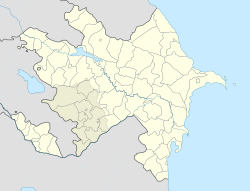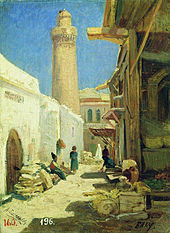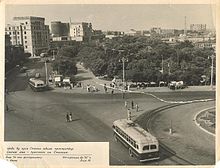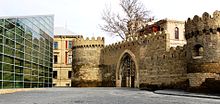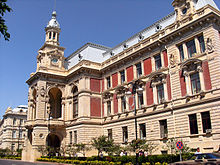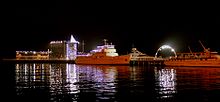
Baku
Did you know...
This Schools selection was originally chosen by SOS Children for schools in the developing world without internet access. It is available as a intranet download. SOS Children has looked after children in Africa for forty years. Can you help their work in Africa?
| Baku Bakı |
|||
|---|---|---|---|
| Night view of Baku | |||
|
|||
|
|
|||
| Coordinates: 40°23′43″N 49°52′56″E Coordinates: 40°23′43″N 49°52′56″E | |||
| Country | |||
| Government | |||
| • Mayor | Hajibala Abutalybov | ||
| Area | |||
| • Total | 2,130 km2 (820 sq mi) | ||
| Elevation | −28 m (−92 ft) | ||
| Population (2012) | |||
| • Total | 2,122,300 | ||
| • Density | 996.38/km2 (2,580.6/sq mi) | ||
| Time zone | AZT ( UTC+4) | ||
| • Summer ( DST) | AZST ( UTC+5) | ||
| Postal code | AZ1000 | ||
| Area code(s) | (+994) 12 | ||
| Vehicle registration | 10-90 AZ | ||
| Website | BakuCity.az | ||
Baku ( Azerbaijani: Bakı, IPA: [bɑˈcɯ]) is the capital and largest city of Azerbaijan, as well as the largest city on the Caspian Sea and of the Caucasus region. It is located on the southern shore of the Absheron Peninsula, which projects into the Caspian Sea. The city consists of two principal parts: the downtown and the old Inner City (21.5 ha). Baku's urban population at the beginning of 2009 was estimated at just over two million people. Officially, about 25 percent of all inhabitants of the country live in the metropolitan city area of Baku.
Baku is divided into eleven administrative districts (raions) and 48 townships. Among these are the townships on islands in the Baku Bay and the town of Oil Rocks built on stilts in the Caspian Sea, 60 km (37 mi) away from Baku. The Inner City of Baku along with the Shirvanshah's Palace and Maiden Tower were inscribed as a UNESCO World Heritage Site in 2000. According to the Lonely Planet's ranking, Baku is also among the world's top ten destinations for urban nightlife.
The city is the scientific, cultural and industrial centre of Azerbaijan. Many sizeable Azerbaijani institutions have their headquarters there, including SOCAR, one of the world's top 100 companies and others. The Baku International Sea Trade Port, sheltered by the islands of the Baku Archipelago to the east and the Absheron Peninsula to the north, is capable of handling two million tons of general and dry bulk cargoes per year. Baku hosted the 57th Eurovision Song Contest in 2012 and will host the 2015 European Games.
Etymology

The name Baku is widely believed to be derived from the old Persian names of the city باد-کوبه Bād-kube, meaning "Wind-pounded city", in which bād means "wind" and kube is rooted in the verb کوبیدن kubidan, "to pound", thus referring to a place where wind is strong and pounding. Indeed, the city is renowned for its fierce winter snow storms and harsh winds. It is also believed that Baku refers to Baghkuh, meaning "Mount of God". Baga (now باغ bagh) and kaufa (now kuh) are the Old Persian words for "god" and "mountain" respectively; the name Baghkuh may be compared with Baghdād ("God-given") in which dād is the Old Persian word for "give". Arabic sources refer to the city as Baku, Bakukh, Bakuya, and Bakuye, all of which seem to come from a Persian name.
Various different hypotheses were also proposed to explain the etymology of the word Baku. According to L.G.Lopatinski and Ali Huseynzade Baku is derived from Turkic word for "hill". Caucasian history specialist Kerope Patkanov also explains the name as "hill" but in the Lak language. The Turkish Islamic Encyclopedia presents the origin of the word Baku as being derived from the words Bey-Kyoy, which mean "the main city" in Turkic. Another theory suggests that the name Baku is derived from the ancient Caucasian Albanian city which was called Baguan.
History
| Walled City of Baku with the Shirvanshah's Palace and Maiden Tower | |
|---|---|
| Name as inscribed on the World Heritage List | |
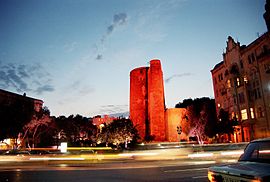 |
|
| Country | Azerbaijan |
| Type | Cultural |
| Criteria | iv |
| Reference | 958 |
| UNESCO region | Europe |
| Inscription history | |
| Inscription | 2000 (24th Session) |
| Endangered | 2003–2009 |
The first written evidence for Baku dates to the 1st century AD.
The city became important after an earthquake destroyed Shamakhy in the 12th century, when the ruling Shirvanshah, Akhsitan I, chose Baku as the new capital. In 1501, Safavid Shah Ismail I laid siege to Baku. At this time the city was enclosed within the lines of strong walls, which were washed by the sea on one side and protected by a wide trench on land. In 1540 Baku was again captured by the Safavid troops. In 1604 the Baku fortress was destroyed by Safavid Shah Abbas I.
On 26 June 1723, after a long siege and cannon fire, Baku surrendered to the Russians. According to Peter the Great's decree the soldiers of two regiments (2,382 people) were left in the Baku garrison under the command of Prince Baryatyanski, the commandant of the city. In 1795, Baku was invaded by Agha Muhammad Khan Qajar to defend against tsarist Russia's ambitions to subjugate the South Caucasus. In the spring of 1796, by Catherine II's order, General Zubov's troops began a major campaign in Transcaucasia. Baku surrendered after the first demand of Zubov, who had sent 6,000 troops to capture the city. On 13 June 1796 the Russian flotilla entered Baku Bay and a garrison of Russian troops was placed in the city. General Pavel Tsitsianov was appointed Baku's commandant. Later, however, Czar Paul I ordered him to cease the campaign and withdraw Russian forces. In March 1797 the tsarist troops left Baku, but a new tsar, Alexander I, began to show a special interest in capturing Baku. In 1803, Tsitsianov reached an agreement with the Baku khan to a compromise, but the agreement was soon annulled. On 8 February 1806, upon the surrendering of Baku, Huseyngulu khan of Baku stabbed and killed Tsitsianov at the gates of the city.
In 1813, Russia signed the Treaty of Gulistan with Persia, which provided for the cession of Baku and most of the Caucasus from Iran and their annexation by Russia.
Professor A. V. Williams Jackson of Columbia University wrote in his work From Constantinople to the Home of Omar Khayyam (1911):
Baku is a city founded upon oil, for to its inexhaustible founts of naphtha it owes its very existence, its maintenance, its prosperity.... At present Baku produces one-fifth of the oil that is used in the world, and the immense output in crude petroleum from this single city far surpasses that in any other district where oil is found. Verily, the words of the Scriptures find illustration here: 'the rock poured me out rivers of oil.'
Oil is in the air one breathes, in one's nostrils, in one's eyes, in the water of the morning bath (though not in the drinking water, for that is brought in bottles from distant mineral springs), in one's starched linen – everywhere. This is the impression one carries away from Baku, and it is certainly true in the environs.
The first oil well was mechanically drilled in the Bibi-Heybat suburb of Baku in 1846, though a number of hand-dug wells predate it. Large-scale oil exploration started in 1872, when Russian imperial authorities auctioned the parcels of oil-rich land around Baku to private investors. Within a short period of time Swiss, British, French, Belgian, German, Swedish and American investors appeared in Baku. Among them were the firms of the Nobel brothers together with the family von Börtzell-Szuch (Carl Knut Börtzell, who also owned the Livadia Palace) and the Rothschild family. An industrial oil belt, better known as Black City, was established near Baku. By the beginning of the 20th century almost half of world production was being extracted in Baku.
In 1917, after the October revolution and amidst the turmoil of World War I and the breakup of the Russian Empire, Baku came under the control of the Baku Commune, which was led by veteran Bolshevik Stepan Shaumyan. Seeking to capitalize on the existing inter-ethnic conflicts, by spring 1918, Bolsheviks inspired and condoned civil warfare in and around Baku. During the infamous March Days, Bolsheviks and Dashnaks seeking to establish control over the Baku streets, were faced with armed Muslim groups. Muslims suffered a crushing defeat by the united forces of the Baku Soviet and were massacred by Dashnak teams. On 28 May 1918, the Azerbaijani faction of the Transcaucasian Sejm proclaimed the independent Azerbaijan Democratic Republic (ADR) in Ganja. Shortly after, Azerbaijani forces, with support of the Ottoman Army of Islam led by Nuru Pasha, started their advance into Baku, eventually capturing the city from the loose coalition of Bolsheviks, Esers, Dashnaks, Mensheviks and British forces under the command of General Lionel Dunsterville on 15 September 1918. Thousands of Armenians in the city were massacred in revenge for the earlier March Days. Baku became the capital of the ADR. On 28 April 1920, the 11th Red Army invaded Baku and reinstalled the Bolsheviks, making Baku the capital of the Azerbaijan Soviet Socialist Republic.
During the continuing Nazi German invasion of the southwestern Soviet Union, capturing the oil fields of Baku would have been one of the ultimate goals of Operation Edelweiss, carried out between May and November 1942. The German Army's closest approach to Baku was no closer than some 530 kilometers (330 miles) northwest of Baku in November 1942, falling far short of the city's capture before being driven back during the Soviet Operation Little Saturn in mid-December 1942.
With the initiatives for saving the city in the 21st century, Baku embarked on a process of restructuring on a scale unseen in its history. Thousands of buildings from Soviet period were demolished to make way for a green belt on its shores; parks and gardens were built on the land reclaimed by filling up the beaches of the Baku Bay. Improvements were made in the general cleaning, maintenance, and garbage collection, and these services are now at Western European standards. The city is growing dynamically and developing at full speed on an east-west axis along the shores of the Caspian Sea.
Geography
Baku is situated on the western coast of Caspian Sea. In the vicinity of the city there are a number of mud volcanoes (Keyraki, Bogkh-bogkha, Lokbatan and others) and salt lakes ( Boyukshor, Khodasan and so on).
Climate
Baku has a subtropical semi-arid climate ( Köppen climate classification: BSk) with warm to hot and dry summers, cold to mild and occasionally wet winters, and strong winds all year long. However, unlike many other cities with this climate, Baku does not see extremely hot summers. This is largely because of its northerly latitude and the fact that it is located on a peninsula on the shore of the Caspian Sea. Baku and the Absheron Peninsula on which it is situated, is the most arid part of Azerbaijan ( precipitation here is around or less than 200 mm (8 in) a year). The majority of the light annual precipitation occurs in seasons other than summer, but none of these months are particularly wet. During Soviet times, Baku with its long hours of sunshine and dry healthy climate, was a vacation destination where citizens could enjoy beaches or relax in now-dilapidated spa complexes overlooking the Caspian Sea. The city's past as a Soviet industrial centre has left it as one of the most polluted cities in the world.
At the same time Baku is noted as a very windy city throughout the year, and gale-force winds, the cold northern wind khazri and the warm southern wind gilavar are typical here in all seasons. Indeed, the city is renowned for its fierce winter snow storms and harsh winds. The speed of the khazri sometimes reaches 144 kph (89 mph), which can cause damage to crops, trees and roof tiles.
The daily mean temperature in July and August averages 26.4 °C (79.5 °F), and there is very little rainfall during that season. During summer the khazri sweeps through, bringing desired coolness. Winter is cold and occasionally wet, with the daily mean temperature in January and February averaging 4.3 °C (39.7 °F). During winter the khazri sweeps through; driven by masses of polar air; temperatures on the coast frequently drop below freezing and make it feel bitterly cold. Winter snow storms are occasional, snow usually remains only for a few days after each snowfall.
The average annual temperature in Baku and that of the Earth differ by less than 0.1 °C (0.18 °F) : it is 14.2 °C (57.6 °F).
| Climate data for Baku | |||||||||||||
|---|---|---|---|---|---|---|---|---|---|---|---|---|---|
| Month | Jan | Feb | Mar | Apr | May | Jun | Jul | Aug | Sep | Oct | Nov | Dec | Year |
| Average high °C (°F) | 6.6 (43.9) |
6.3 (43.3) |
9.8 (49.6) |
16.4 (61.5) |
22.1 (71.8) |
27.3 (81.1) |
30.6 (87.1) |
29.7 (85.5) |
25.6 (78.1) |
19.6 (67.3) |
13.5 (56.3) |
9.7 (49.5) |
18.1 (64.6) |
| Daily mean °C (°F) | 4.4 (39.9) |
4.2 (39.6) |
7.0 (44.6) |
12.9 (55.2) |
18.5 (65.3) |
23.5 (74.3) |
26.4 (79.5) |
26.3 (79.3) |
22.5 (72.5) |
16.6 (61.9) |
11.2 (52.2) |
7.3 (45.1) |
15.1 (59.2) |
| Average low °C (°F) | 2.1 (35.8) |
2.0 (35.6) |
4.2 (39.6) |
9.4 (48.9) |
14.9 (58.8) |
19.7 (67.5) |
22.2 (72) |
22.9 (73.2) |
19.4 (66.9) |
13.6 (56.5) |
8.8 (47.8) |
4.8 (40.6) |
12.0 (53.6) |
| Precipitation mm (inches) | 21 (0.83) |
20 (0.79) |
21 (0.83) |
18 (0.71) |
18 (0.71) |
8 (0.31) |
2 (0.08) |
6 (0.24) |
15 (0.59) |
25 (0.98) |
30 (1.18) |
26 (1.02) |
210 (8.27) |
| Avg. precipitation days (≥ 0.1 mm) | 6 | 6 | 5 | 4 | 3 | 2 | 1 | 2 | 2 | 6 | 6 | 6 | 49 |
| Avg. snowy days (≥ 1 cm) | 4 | 3 | 0 | 0 | 0 | 0 | 0 | 0 | 0 | 0 | 0 | 3 | 10 |
| Mean monthly sunshine hours | 89.9 | 89.0 | 124.0 | 195.0 | 257.3 | 294.0 | 313.1 | 282.1 | 222.0 | 145.7 | 93.0 | 102.3 | 2,207.4 |
| Source #1: World Meteorological Organisation (UN), Hong Kong Observatory for data of sunshine hours | |||||||||||||
| Source #2: Meoweather (Snowy days) | |||||||||||||
Administrative divisions
Today, Baku is divided into 11 raions (administrative districts) and 5 settlements of city type. The mayor, presently Hajibala Abutalybov, embodies the executive power of the city.
|
|
Demographics
| Year | Azeris | % | Russians | % | Armenians | % | Jews | % | Others | % | Total |
|---|---|---|---|---|---|---|---|---|---|---|---|
| 1886 | 37,530 | 43.3 | 21,390 | 24.7 | 24,490 | 28.3 | 391 | 0.5 | 2,810 | 3.2 | 86,611 |
| 1897 | 40,341 | 36 | 37,399 | 33.4 | 19,099 | 17.1 | 3,369 | 3 | 11,696 | 10.5 | 111,904 |
| 1926 | 118,737 | 26.2 | 167,373 | 36.9 | 76,656 | 16.9 | 19,589 | 4.3 | 70,978 | 15.7 | 453,333 |
| 1939 | 215,482 | 27.4 | 343,064 | 43.6 | 118,650 | 15.1 | 31,050 | 3.9 | 79,377 | 10.1 | 787,623 |
| 1959 | 211,372 | 32.9 | 223,242 | 34.7 | 137,111 | 21.3 | 24,057 | 3.7 | 56,725 | 8.7 | 652,507 |
| 1970 | 586,052 | 46.3 | 351,090 | 27.7 | 207,464 | 16.4 | 29,716 | 2.3 | 88,193 | 6.9 | 1,262,515 |
| 1979 | 530,556 | 52.4 | 229,873 | 22.7 | 167,226 | 16.5 | 22,916 | 2.3 | 62,865 | 6.2 | 1,013,436 |
| 1999 | 1,574,252 | 88 | 119,371 | 6.7 | 378 | 0.02 | 5,164 | 0.3 | 89,689 | 5 | 1,788,854 |
| 2009 | 1,848,107 | 90.3 | 108,525 | 5.3 | 104 | 0 | 6,056 | 0.6 | 83,023 | 4.1 | 2,045,815 |
Until 1988 Baku had very large Russian, Armenian, and Jewish populations which contributed to cultural diversity and added in various ways (music, literature, architecture and progressive outlook) to Baku's history. With the onset of the Karabakh War and the pogrom against Armenians starting in January 1990, the city's large Armenian population was expelled. Under Communism, the Soviets took over the majority of Jewish property in Baku and Kuba. Since the collapse of the Soviet Union, Azerbaijani President Heydar Aliyev has returned several synagogues and a Jewish college nationalized by the Soviets to the Jewish community. He has encouraged the restoration of these buildings and is well liked by the Jews of Azerbaijan. Renovation has begun on seven of the original 11 synagogues, including the Gilah synagogue, built in 1896, and the large Kruei Synagogue.
Ethnic groups
Today the vast majority of the population of Baku are ethnic Azerbaijanis (more than 90%). The intensive growth of the population started in the middle of the 19th century when Baku was a small town with a population of about 7,000 people. The population increased again from about 13,000 in the 1860s to 112,000 in 1897 and 215,000 in 1913, making Baku the largest city in the Caucasus region.
Baku has been a cosmopolitan city at certain times during its history, meaning ethnic Azerbaijanis did not constitute the majority of population. In 2003 Baku additionally had 153,400 internally displaced persons and 93,400 refugees.
Religion

The urban landscape of Baku is shaped by many communities. The religion with the largest community of followers is Islam. The majority of the Muslims are Shia Muslims, and the Republic of Azerbaijan has the second highest Shia population percentage in the world after Iran. Zoroastrianism had a long history in Azerbaijan, evident in sites such as the Fire Temple of Baku or ceremonies like Nowruz, along with Manichean. The city's notable mosques include Juma Mosque, Bibi-Heybat Mosque, Muhammad Mosque and Taza Pir Mosque.
There are some other faiths practiced among the different ethnic groups within the country. By article 48 of its Constitution, Azerbaijan is a secular state and ensures religious freedom. Religious minorities include Russian Orthodox Christians, Catholic Levantines, Ashkenazi Jews and Sufi Muslims.
Economy

Baku's largest industry is petroleum, and its petroleum exports make it a large contributor to Azerbaijan's balance of payments. The existence of petroleum has been known since the 8th century. In the 10th century, the Arabian traveler, Marudee, reported that both white and black oil were being extracted naturally from Baku. By the 15th century, oil for lamps was obtained from hand-dug surface wells. Commercial exploitation began in 1872, and by the beginning of the 20th century the Baku oil fields were the largest in the world. Towards the end of the 20th century much of the onshore petroleum had been exhausted, and drilling had extended into the sea offshore. By the end of the 19th century skilled workers and specialists flocked to Baku. By 1900 the city had more than 3,000 oil wells, of which 2,000 were producing oil at industrial levels. Baku ranked as one of the largest centres for the production of oil industry equipment before World War II. The World War II Battle of Stalingrad was fought to determine who would have control of the Baku oil fields. Fifty years before the battle, Baku produced half of the world's oil supply.
Currently the oil economy of Baku is undergoing a resurgence, with the development of the massive Azeri-Chirag-Guneshli field (Shallow water Gunashli by SOCAR, deeper areas by a consortium led by BP), development of the Shah Deniz gas field, the expansion of the Sangachal Terminal and the construction of the BTC Pipeline.
The Baku Stock Exchange is Azerbaijan's largest stock exchange, and largest in the Caucasian region by market capitalization. A relatively large number of transnational companies are headquartered in Baku. One of the more prominent institutions headquartered in Baku is the International Bank of Azerbaijan, which is run by Dr. Jahangir Hajiyev and employs over 1,000 people. International banks with branches in Baku include HSBC, Société Générale and Credit Suisse.
Tourism and shopping
Baku is one of the most important tourist destinations in the Caucasus, with hotels in the city earning 7 million euros in 2009. Many sizable world hotel chains have a presence in the city. Baku has many popular tourist and entertainment spots, such as the downtown Fountains Square, the One and Thousand Nights Beach, Shikhov Beach and Oil Rocks. Baku's vicinities feature Yanar Dag, an ever-blazing spot of natural gas. On 2 September 2010, with the inauguration of National Flag Square, Baku became home to the world's tallest flagpole, according to the Guinness Book of Records.
Baku has several shopping malls; the two most famous city centre malls are AF MALL and Park Bulvar. The retail areas contain shops from chain stores up to high-end boutiques.
The city is listed 48th in the 2011 list of the most expensive cities in the world conducted by the Mercer Human Resource Consulting. Its Nizami street is one of the most expensive streets in the world.
Culture
The city has many amenities that offer a wide range of cultural activities, drawing both from a rich local dramatic portfolio and an international repertoire. It also boasts many museums such as Baku Museum of Modern Art and Azerbaijan State Museum of History, most notably featuring historical artifacts and art. Many of the city's cultural sites were celebrated in 2009 when Baku was designated an Islamic Culture Capital. Baku was also chosen to host the Eurovision Dance Contest 2010.
Among Baku's prestigious cultural venues are Azerbaijan State Philharmonic Hall, Azerbaijan State Academic Opera and Ballet Theatre. The main movie theatre is Azerbaijan Cinema. Festivals include the Baku International Film Festival, Baku International Jazz Festival, Novruz Festival, Gül Bayramı (Flower Festival) and the National Theatre Festival. International and local exhibitions are provided in Baku Expo Centre.
Architecture
Baku has wildly varying architecture, ranging from the Old City core to modern buildings and the spacious layout of the Baku port. Many of the city's most impressive buildings were built during the early 20th Century, when architectural elements of the European styles were combined in eclectic style. Baku thus has an original and unique appearance, earning it a reputation as the 'Paris of the East'.
Late modern and postmodern architecture began to appear in the early 2000s. With economic development, old buildings such as Atlant House were razed to make way for new ones. Buildings with all-glass shells have appeared around the city, the most prominent examples being the SOCAR Tower and Flame Towers. These projects also brought the attention of international media as notable programs as Discovery Channel's Extreme Engineering featured changes in the city.
The Old City of Baku, also known as the Walled City of Baku, refers to the ancient Baku settlement. Most of the walls and towers, strengthened after the Russian conquest in 1806, survived. This section is picturesque, with its maze of narrow alleys and ancient buildings: the cobbled streets past the Palace of the Shirvanshahs, two caravansaries, the baths and the Juma Mosque (which used to house the Azerbaijan National Carpet and Arts Museum but is now a mosque again). The old town core also has dozens of small mosques, often without any particular sign to distinguish them as such.
In 2003, UNESCO placed the Inner City on the List of World Heritage in Danger, citing damage from a November 2000 earthquake, poor conservation as well as "dubious" restoration efforts.
Parks and gardens
Baku has large sections of greenery either preserved by the National Government or designated as green zones. The city, however, continues to lack a green belt development as economic activity pours into the capital, resulting in massive housing projects along the suburbs.
Baku Boulevard is a pedestrian promenade that runs parallel to Baku's seafront. The boulevard contains an amusement park, yacht club, musical fountain, statues and monuments. The park is popular with dog-walkers and joggers, and is convenient for tourists. It is adjacent to the newly built International Centre of Mugham and the musical fountain.
Other prominent parks and gardens include Heydar Aliyev Park, Samad Vurgun Park, Narimanov Park, Alley of Honour and the Fountains Square. The Martyrs' Lane, formerly the Kirov Park, is dedicated to the memory of those who lost their lives during the Nagorno-Karabakh War and also to the 137 people killed on Black January.
Nightlife
Baku boasts a vibrant nightlife. Many clubs that are open until dawn can be found throughout the city. Clubs with an eastern flavor provide special treats from the cuisine of Azerbaijan along with local music. Western-style clubs target younger, more energetic crowds. Most of the public houses and bars are located near Fountains Square and are usually open until the early hours of the morning.
Baku is home to restaurants catering to every cuisine and occasion. Restaurants range from luxurious and expensive to ordinary and affordable.
In the Lonely Planet "1000 Ultimate Experiences", Baku placed 8th among the top 10 party cities in the world.
Sports
The city's three main football clubs are Neftchi Baku, FC Baku and Inter Baku of whom first two play at the Tofiq Bahramov Stadium. Neftchi has won six Azerbaijani titles, whilst FC Baku and Inter Baku have just two titles for each. Baku also has several clubs in the premier and regional leagues, including AZAL and Ravan Baku in Premier League. The Baku Olympic Stadium, a planned 65,000 seat football (soccer) stadium, is currently under construction and will be based on Boyuk Shor settlement.
In the Azerbaijan Basketball League, Baku is represented by Gala BC Baku, BC Aztop Baku, NTD Devon Baku whose home is the Palace of Hand Games. The city also is home of the volleyball clubs such as Rabita Baku, Azerrail Baku, Lokomotiv Baku, Igtisadchi Baku and VC Baku.
First class sporting facilities were built for the indoor games, including the Palace of Hand Games and Heydar Aliyev Sports and Exhibition Complex. It hosted many sporting events, including FIFA U-17 Women's World Cup, Rhythmic Gymnastics European Championships in 2007 and 2009, 2005 World Rhythmic Gymnastics Championships, 2007 FILA Wrestling World Championships and 2010 European Wrestling Championships, 2011 World Amateur Boxing Championships, 2009 Women's Challenge Cup and European Taekwondo Championships in 2007. Since 2011 the city annually hosts WTA tennis event called Baku Cup.
Baku is also one of world's leading chess centres, having produced famous grandmasters like Teimour Radjabov, Vugar Gashimov, Garry Kasparov, and Rauf Mammadov, as well as the arbiter Faik Hasanov. The city also annually hosts the international tournaments such as Baku Chess Grand Prix, President's Cup, Baku Open and currently bidding to host 42nd Chess Olympiad in 2014.
Baku will host the 2015 European Games which will be the first European Games to be held.
Baku made a bid to host the 2016 Summer Olympics and later made a bid for the 2020 Summer Olympics. However, Baku failed to become a Candidate City both times.
Transport
Throughout history the transport system of Baku used the now-defunct horsecars, trams and narrow gauge railways. As of 2011, 1000 black cabs are ordered by Baku Taxi Company, and as part of a programme originally announced by the Transport Ministry of Azerbaijan, there is a plan to introduce London cabs into Baku. The move was part of £16 million agreement between Manganese Bronze and Baku Taxi Company.
Local transport includes the Baku Metro, a rapid-transit system notable for its art, murals, mosaics, and ornate chandeliers. Baku Metro was opened in November 1967 and includes 22 stations at present; 170 million people used Baku Metro over the past five years. In 2008, the Chief of the Baku Metro, Taghi Ahmadov, announced plans to construct 41 new stations over the next 17 years. These will serve the new bus complex as well as the international airport.
Plans are afoot to introduce a single Smart Card for payment on all types of city transport. The metro is now the only form of transport in Baku to use any type of card-based fare-payment system.
Baku's Central Railway Station is the terminus for national and international rail links to the city. The Kars–Tbilisi–Baku railway, which will directly connect Turkey, Georgia and Azerbaijan, began to be constructed in 2007 and is scheduled for completion in 2013. The completed branch will connect Baku with Tbilisi in Georgia, and from there trains will continue to Akhalkalaki, and Kars in Turkey.
Sea transport is vital for Baku, as the city is practically surrounded by the Caspian Sea to the east. Shipping services operate regularly from Baku across the Caspian Sea to Turkmenbashi (formerly Krasnovodsk) in Turkmenistan and to Bandar Anzali and Bandar Nowshar in Iran. The commuter ferries, along with the high-speed catamaran Seabus (Deniz Avtobusu), also form the main connection between the city and the Absheron peninsula.
The Baku Port was founded in 1902 and since then has been the largest Caspian Sea port. It has six facilities: the main cargo terminal, the container terminal, the ferry terminal, the oil terminal, the passenger terminal and the port fleet terminal. The port's throughput capacity reaches 15 million tons of liquid bulk and up to 10 million tons of dry cargoes. Beginning in 2010, the Baku International Sea Trade Port is being reconstructed. The construction will take in three stages and will be completed by 2016. The estimated costs are 400 Million US$. From April to November the Baku Port is accessible to ships loading cargoes for direct voyages from Western European and Mediterranean ports.
The State Road M-1 and the European route E60 are the two main motorway connections between Europe and Azerbaijan. The motorway network around Baku is well developed and is constantly being extended.
The Heydar Aliyev International Airport is the only commercial airport serving Baku. The new Baku Cargo Terminal was officially opened in March 2005. It was constructed to be a major cargo hub in the CIS countries and is actually now one of the biggest and most technically advanced in the region. There are also several smaller military airbases near Baku, such as Baku Kala Air Base, intended for private aircraft, helicopters and charters.
Public services
Education
Baku has many universities, junior colleges, and vocational schools. Many of Azerbaijan's most prestigious universities are in Baku, including Baku State University, Azerbaijan State Oil Academy, Academy of Public Administration, Azerbaijan Medical University, and Azerbaijan National Academy of Sciences. Some of the biggest educational institutions in Baku are Azerbaijan State Economic University, Azerbaijan Technical University, Azerbaijan Architecture and Construction University, Azerbaijan University of Languages, Baku Slavic University, Azerbaijan Tourism Institute and Baku Academy of Music. After Azerbaijan gained independence, the fall of communism led to the development of a number of private institutions, including Qafqaz University, Odlar Yurdu University, Khazar University and Western University. Publicly run kindergartens and elementary schools (years 1 through 11) are operated by local wards or municipal offices.
Baku has numerous libraries, many of which contain vast collections of historic documents from the Roman, Byzantine, Ottoman and Soviet periods, as well as from other civilisations of the past. The most important libraries in terms of historic document collections include the Nizami Museum of Azerbaijan Literature, National Library of Azerbaijan, Mirza Alakbar Central Library, Samad Vurgun Library and Baku Presidential Library.
Health care
The city has many public and private hospitals, clinics and laboratories within its bounds and numerous medical research centers. Many of these facilities have high technology equipment, which has contributed to the recent upsurge in " medical tourism" to Baku, particularly from post-Soviet countries such as Georgia and Moldova, whose governments send lower-income patients to the city for inexpensive high-tech medical treatments and operations.
Notable residents
Because of its intermittent periods of great prosperity as well as being the largest city in the Caucasus and one of the most ethnically and culturally diverse in the Soviet Union, Baku prides itself on having produced a disproportionate number of notable figures in the sciences, arts and other fields. Some of the houses they resided in display commemorative plaques. Some of the many prestigious residents include: Academy Award winners Rustam Ibrahimbeyov and Vladimir Menshov, one of the founders and head of the Soviet space program Kerim Kerimov, Nobel Prize winner and physicist Lev Landau and famous musicians such as Gara Garayev, Uzeyir Hajibeyov, Muslim Magomayev, Vagif Mustafazadeh, and Alim Qasimov. World-famous cellist Mstislav Rostropovich was born and raised in Baku, as was world famous chess player, Gary Kasparov.
International relations
Twin towns and sister cities
Baku is twinned with:[in chronological order]
| Country | City | State / Province / Region / Governorate | Date | |||
|---|---|---|---|---|---|---|
| Senegal | Dakar | Dakar Region | 1967 | |||
| Italy | Naples | Campania | 1972 | |||
| Iraq | Basra | Basra Governorate | 1972 | |||
| Bosnia and Herzegovina | Sarajevo | Sarajevo Canton | 1975 | |||
| United States | Houston | Texas | 1976 | |||
| France | Bordeaux | Aquitaine | 1979 | |||
| Iran | Tabriz | East Azerbaijan Province | 1980 | |||
| Turkey | Izmir | İzmir Province | 1985 | |||
| Vietnam | Vũng Tàu | Bà Rịa–Vũng Tàu Province | 1985 | |||
| United States | Honolulu | Hawaii | 1998 |
Partner cities
- Aberdeen, Scotland
- Mainz, Germany
- Stavanger, Norway
Partnership relations also exist at different levels with: Berlin, Paris, Vienna, Tbilisi, Astana, Minsk, Moscow, Volgograd, Kizlyar, Tashkent and Chengdu.


